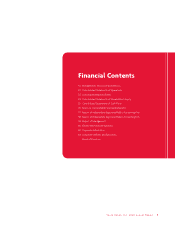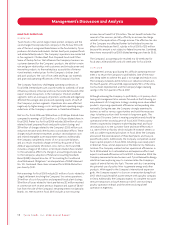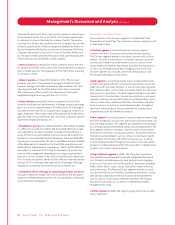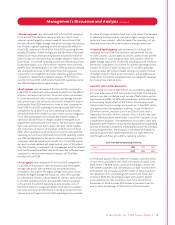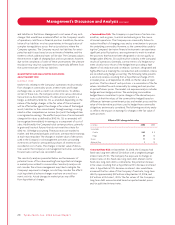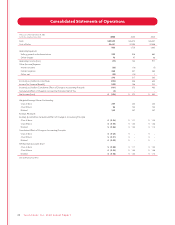Tyson Foods 2006 Annual Report Download - page 21
Download and view the complete annual report
Please find page 21 of the 2006 Tyson Foods annual report below. You can navigate through the pages in the report by either clicking on the pages listed below, or by using the keyword search tool below to find specific information within the annual report.
either against the change in fair value of the hedged assets, liabili-
ties or firm commitments through earnings or recognized in other
comprehensive income (loss) until the hedged item is recognized in
earnings. The ineffective portion of an instrument’s change in fair
value is recognized immediately in earnings as a component of cost
of sales. Instruments the Company holds as part of its risk manage-
ment activities that do not meet the criteria for hedge accounting,
as defined by SFAS No. 133, as amended, are marked to fair value
with unrealized gains or losses reported currently in earnings. The
Company generally does not hedge anticipated transactions
beyond 12 months.
• Contingent liabilities: The Company is subject to lawsuits, inves-
tigations and other claims related to wage and hour/labor, livestock
procurement, securities, environmental, product, taxing authorities
and other matters, and is required to assess the likelihood of any
adverse judgments or outcomes to these matters, as well as poten-
tial ranges of probable losses. A determination of the amount of
reserves and disclosures required, if any, for these contingencies are
made after considerable analysis of each individual issue. These
reserves may change in the future due to changes in the Company’s
assumptions, the effectiveness of strategies or other factors
beyond the Company’s control.
• Accrued self insurance: Insurance expense for health and welfare,
workers’ compensation, auto liability and general liability risks are
estimated using experience and actuarial estimates. The assump-
tions used to arrive at periodic expenses are reviewed regularly by
management. However, actual expenses could differ from these
estimates, which could result in adjustments to amounts recorded.
• Pension and other postretirement benefits: The Company
provides a range of benefits to its employees and retired employees,
including pensions and postretirement healthcare benefits. The
Company records annual amounts related to these plans based on
calculations specified by generally accepted accounting principles,
which include various actuarial assumptions, such as discount rates,
assumed rates of return on plan assets, compensation increases,
turnover rates, mortality rates, retirement rates and healthcare cost
trends. The Company reviews its actuarial assumptions on an annual
basis and makes modifications to the assumptions based on the cur-
rent rates and trends when it is deemed appropriate to do so. The
Company generally recognizes the effect of these modifications
immediately into earnings rather than amortizing the effect over
future periods. See Note 12, “Pension and other postretirement
benefits” of the Notes to Consolidated Financial Statements for a
sensitivity discussion of the assumed healthcare cost trend rates.
• Impairment of long-lived assets: The Company is required to
assess potential impairments to its long-lived assets, which are
primarily property, plant and equipment. If impairment indicators
are present, the Company must measure the fair value of the assets
in accordance with Statement of Financial Accounting Standards
No. 144, “Accounting for the Impairment of Disposal of Long-Lived
Assets,” to determine if adjustments are to be recorded.
• Impairment of goodwill and other intangible assets: In assess-
ing the recoverability of the Company’s goodwill and other intangible
assets, management relies on a number of factors including operat-
ing results, business plans, economic projections, anticipated future
cash flow, assumed royalty rates and marketplace data. There are
inherent uncertainties related to these factors and management’s
judgment in applying these factors to the assessment of recover-
ability. The Company has elected to make the first day of the fourth
quarter the annual impairment assessment date for goodwill and
other intangible assets. Goodwill valuations have been calculated
using an income approach based on the present value of future cash
flows of each reporting unit. Other intangible asset valuations have
been calculated for trademarks using a royalty rate method based
on the present value of future cash flows and for patents and in-process
technology using the cash flow method based on the present value
of future cash flows. Changes in economic and operating conditions
impacting these assumptions could result in goodwill impairment
in future periods. The Company could be required to evaluate the
recoverability of goodwill and other intangible assets prior to the
required annual assessment if the Company experiences disruptions
to the business such as end market conditions, unexpected signifi-
cant declines in operating results, divestiture of a significant compo-
nent of the Company and market capitalization declines. These
types of events and the resulting analysis could result in goodwill
impairment charges in the future. The Company recorded impair-
ments of other intangible assets of $3 million, $4 million and
$25 million in fiscal 2006, 2005 and 2004, respectively.
• Marketing and advertising costs: The Company incurs advertis-
ing, retailer incentive and consumer incentive costs to promote its
products through its marketing programs. These programs include
cooperative advertising, volume discounts, in-store display incen-
tives, coupons and other programs. The recognition of the costs
related to these programs requires management’s judgment in esti-
mating the potential performance and redemption of each program.
These estimates are based on many factors, including experience
of similar promotional programs. Actual expenses may differ if the
performance and redemption rates vary from the estimated rates.
• Income taxes: The Company estimates its total income tax expense
based on statutory tax rates and tax planning opportunities avail-
able to the Company in various jurisdictions in which the Company
earns income. Federal income taxes include an estimate for taxes
on earnings of foreign subsidiaries expected to be remitted to the
United States and be taxable, but not for earnings considered
indefinitely invested in the foreign subsidiary. Deferred income
taxes are recognized for the future tax effects of temporary differ-
ences between financial and income tax reporting using tax rates
in effect for the years in which the differences are expected to
reverse. Valuation allowances are recorded when it is likely a tax
benefit will not be realized for a deferred tax asset. Changes in
tax laws and rates also could affect the recorded deferred tax assets
Ty s o n F o o d s , I n c . 2 0 0 6 A n n u a l R e p o r t 19
Management’s Discussion and Analysis continued


